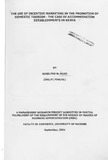| dc.description.abstract | Kenya has depended on earnings from international tourism but this revenue has been
declining since 1994. Reasonsfor decline have been due to insecurity, global terrorism
and competition from other destinations such as South Africa and Egypt. As any other
businessthat is experiencing a downturn, new strategies need to be put in place. An
alternative strategy would be to revamp the domestic tourist segment.
It is on this premise that this study was formulated to try and identify how
accommodation establishments have participated in the promotion of domestic tourism
through offering incentives. The study was done with the objective of establishing the
marketing mix incentives that were being offered by the accommodation establishments
listed by the Kenya Association of Hotelkeepers and Caterers (KAHC), to determine the
extent to which they have promoted domestic tourism through incentive marketing and
determining the problems that they experience while using incentive marketing in the
promotion of domestic tourism.
The population of interest was drawn from accommodation establishments listed by the
Kenya Association of Hotelkeepers and Caterers. The study targeted a sample of 50
establishments out of which 35 (70%) of them responded to the questionnaires mailed
to them. The establishments were categorized as hotels, clubs, lodges and campsites.
The data was analyzed by use of descriptive statistical tests which were in the form of
frequencies, means scores, percentages and cross tabul~pns.
The findings indicate that marketing mix incentives used are product, packaging, place,
price, promotion but the degree differs across the establishments. The study revealed
that conference facilities were the most common product offerings across all the
categories of establishments. Meals were found to be inclusive to a very large extent in
all the establishments while additional value was the most offered price incentive.
Security was key among the place incentives. Reservations are still mainly made on
phone but the use of the internet is becoming increasingly important. Some of the
incentives are location dependent. Sales calls were found to be the most common
promotional activity as they are used to a very large extent. Some of the
accommodation establishments offered incentive travel as a form of promoting domestic
tourism. The major problems experienced were competition, taxation and insecurity.
Incentives offered by the accommodation establishments depend mainly on the category
and location of the establishment. Security and price incentives will drive the volumes of
domestic tourists. Recommendations given in this study include the use of incentive
travel, holiday incentive offerings by the government, reduction in the taxation of
tourism products, industrial building allowance and communication to the market
regarding the incentives being offered. Constraining factors included non-response and
a limited list. There is need to conduct similar studies on other establishments not
coveredin this research and to determine the kind of packagesthat would be motivating
to ordinary Kenyans. | en |

